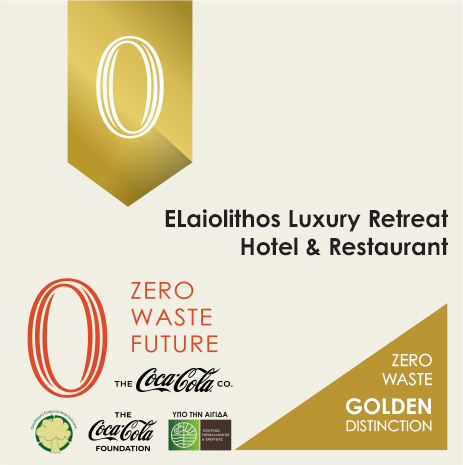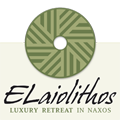When visiting Naxos, one of Greece’s most breathtaking islands, you may find yourself captivated by its natural beauty—rugged mountains, pristine beaches, and charming villages. As you explore the island, you’ll also want to stay hydrated. But the question arises: Can you drink the tap water in Naxos?
The answer, as with many travel destinations, depends on where you are staying and which part of the island you’re visiting. Naxos is an island of contrasts, with a rich history, diverse landscapes, and distinct local traditions. The tap water, much like other aspects of the island, varies depending on your location.
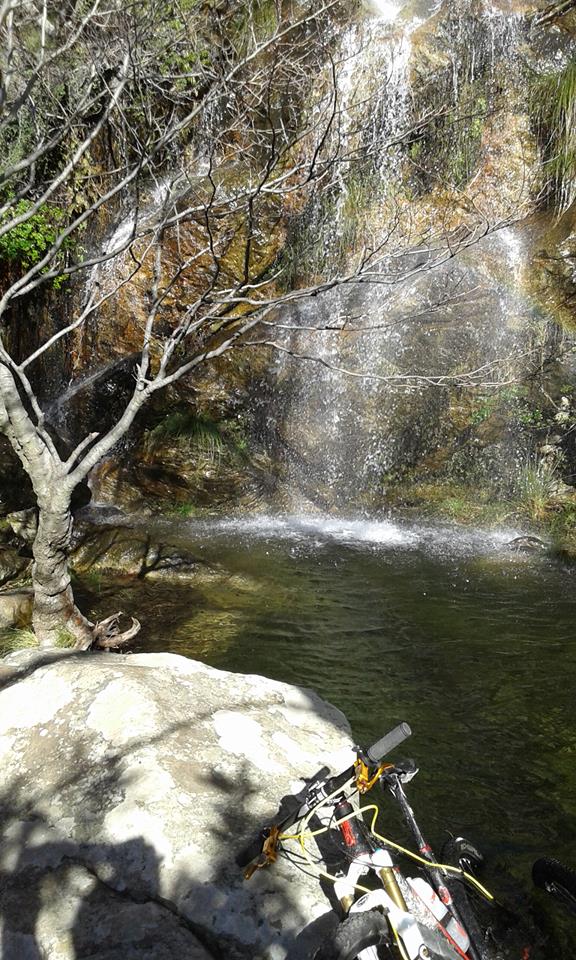
The Mountainous Villages: Pure, Fresh, and Safe
The true natural beauty of Naxos lies in its highlands, where the island’s heart beats strongest. Here, nestled in the quiet, rugged mountains, the villages pride themselves on their pristine water sources. The tap water in these mountain villages—such as those in the interior, far from the bustling tourist hubs—is sourced directly from the nearby mountain springs and boreholes. The water in these areas is not only safe but crisp, fresh, and full of natural purity. It’s as if nature has bottled its finest liquid gift straight from the source, ensuring you experience Naxos at its most authentic.
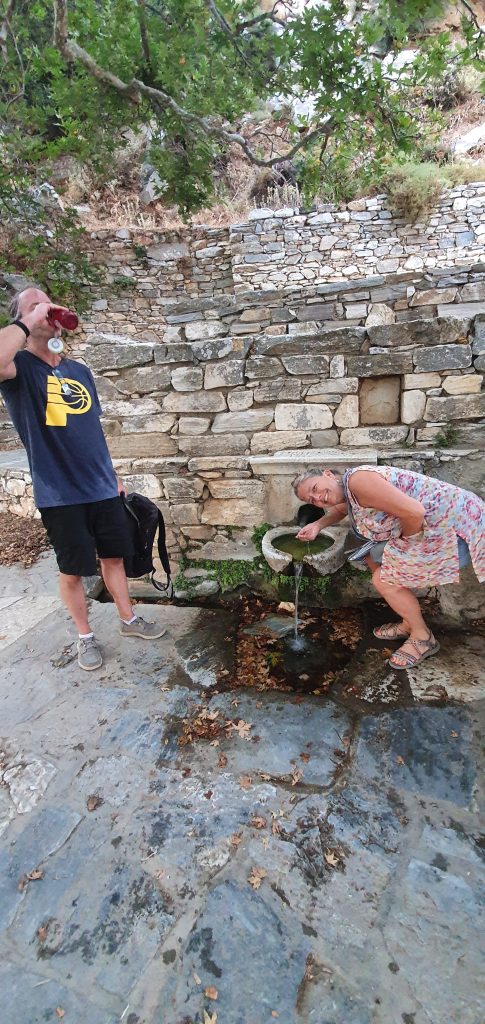
Local residents and visitors in these highland areas can drink the tap water without worry. Whether you’re staying in traditional stone houses in villages in central Naxos and the highlands, you can rest assured that the water is clean and comes straight from the island’s abundant mountain springs or boreholes. For these villages, the water is a symbol of the island’s connection to nature and the community’s respect for the environment.
The Coastal Areas: Use Caution, Stick to Bottled Water
However, as you move closer to the coast and popular tourist areas, the situation changes. Naxos Town and the surrounding beach regions—such as Agia Anna, Agios Prokopios, Plaka Beach, Orkos—do not have the same high-quality tap water. While the water is perfectly suitable for showers, laundry, and cooking, it is not recommended for drinking. The water in the faucets comes from various sources, including boreholes across the island, a water dam, and natural wells.
In these areas, many visitors are told that the water can be made drinkable through filtration systems. While some might choose to rely on water filters, the reality is that the tap water in these regions still poses risks to your health. It’s simply not safe for consumption. To avoid any unpleasant surprises or discomfort, it’s best to purchase bottled water for drinking. Whether you’re staying at a hotel, apartment, or renting a villa, make sure to stock up on bottled water during your stay.
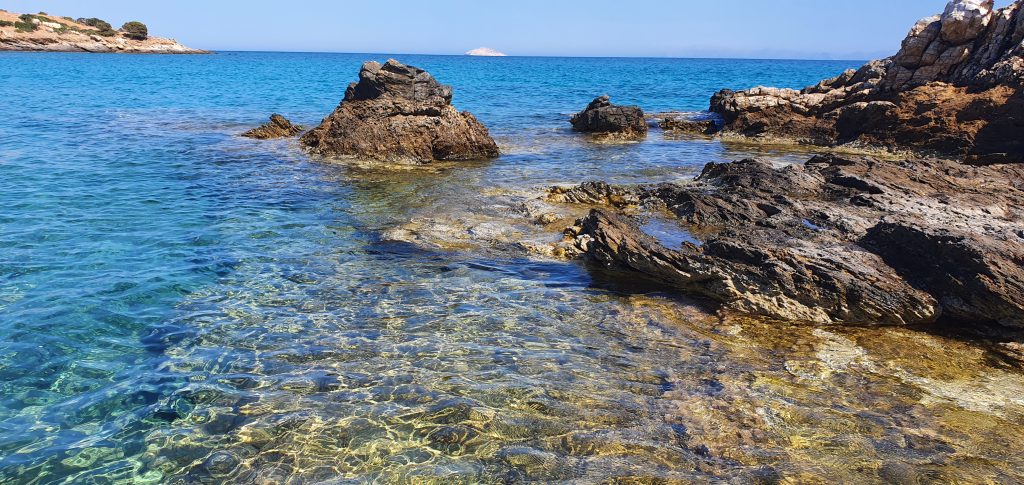
Accessing Clean Drinking Water in Naxos Town: Public Fountains for Residents and Visitors
In addition to the caution around tap water in the coastal regions of Naxos, it’s worth noting that in Naxos town (Hora) and its nearby areas, the Municipality has thoughtfully provided public drinking water fountains. These fountains serve as a modern-day extension of the island’s traditional wells, offering convenient access to fresh, safe drinking water. Located throughout the town and its surroundings, these fountains allow locals and visitors to fill up their bottles or buckets, ensuring easy access to potable water for all. The presence of these fountains makes it easier to stay hydrated while exploring, especially when bottled water might not always be readily available. So, while staying in Naxos Town and its neighboring areas, feel free to refill your bottle at these public fountains to enjoy clean, refreshing water directly sourced from the island’s high-quality springs.
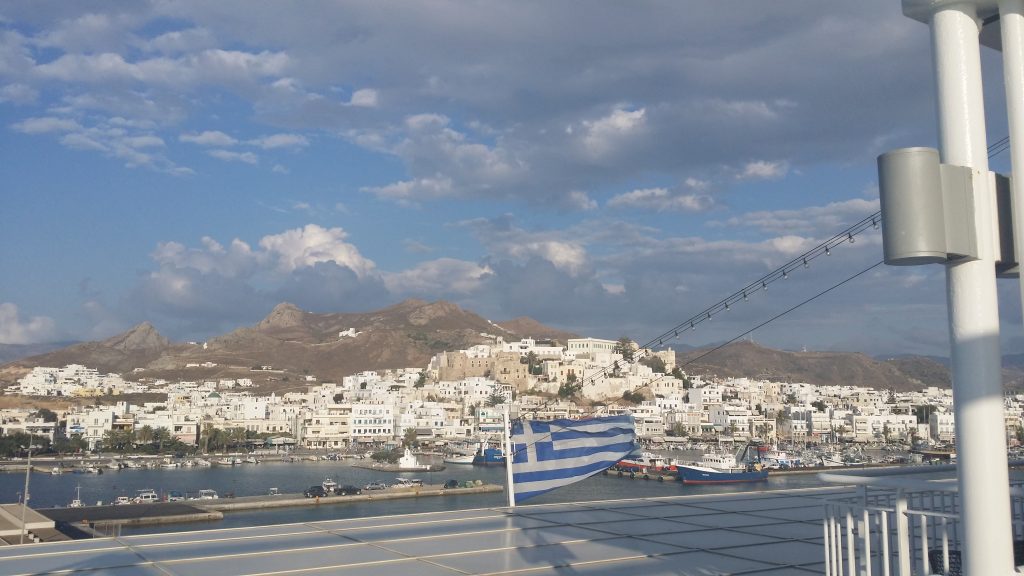
Why Naxos Water is the Way It Is
The reasons behind the varying quality of tap water in Naxos have to do with the infrastructure and natural geography of the island. In the mountainous villages, the proximity to natural springs ensures that water remains uncontaminated, with minimal treatment required. In contrast, the coastal areas—especially those heavily populated by tourists—have more complex water systems. While improvements are continually being made, the water from these regions remains unsuitable for drinking.
Embracing Naxos’ Authenticity
The natural beauty of Naxos is not only found in its picturesque beaches and crystal-clear waters. It is deeply embedded in its villages, especially those nestled in the highlands. In these serene and untouched mountain regions, the tap water is one of the island’s hidden treasures. It’s a reminder of the island’s rich natural resources, its sustainable living practices, and the deep connection between the local communities and the land.
As you sip your bottle of water while wandering the cobblestone streets or relaxing by the sea, remember that Naxos offers more than just beautiful landscapes. The villages, the mountain springs, and the incredible people who call this island home all contribute to the authenticity that makes Naxos one of Greece’s most cherished destinations.

Conclusion
So, can you drink tap water in Naxos? Yes—if you’re in one of the mountain villages, where the water is pure, fresh, and safe to drink. However, if you find yourself near the beaches or in the busier areas, it’s best to stick with bottled water for drinking. While the tap water in these regions may be safe for cooking and showering, always opt for bottled water to stay hydrated safely during your visit.
No matter where you are on the island, whether in the peaceful highlands or the bustling seaside, Naxos will welcome you with its natural beauty, and with a little knowledge, you can experience this enchanting place without a hitch.
The Hidden Water Springs of Naxos: A Journey to the Island’s Natural Aquifers
Naxos, the largest and most fertile island in the Cyclades, is blessed with an abundance of natural springs that have provided fresh water to its inhabitants for centuries. These springs are vital not only for the local communities but also for sustaining the island’s agricultural practices, which have been deeply intertwined with its history. From mountain sources to valley springs, these natural water reserves are part of Naxos’ charm and authenticity. Here’s a look at some of the island’s most renowned springs, each with its unique story and significance.
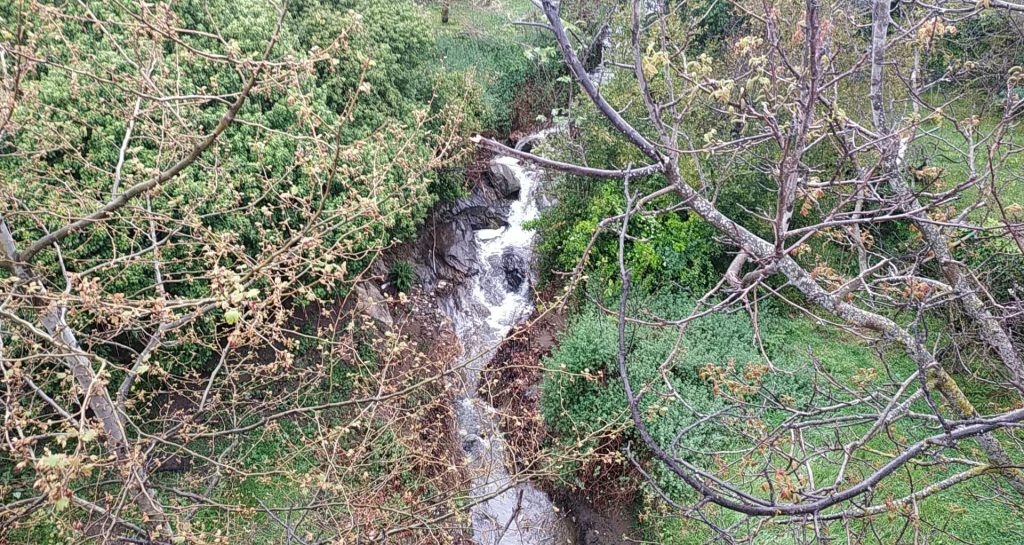
The Fanari Spring: The Lifeline of Moni Village and Its Region
Nestled near the village of Moni, the Fanari Spring is one of the most important water sources in Naxos. Located in the shadow of Fanari Mountain, this spring provides clean, fresh water to Moni and the surrounding areas. The water flows down from the mountains, offering locals and visitors a refreshing taste of Naxos’ pure natural resources. The cool, crystal-clear water has been the lifeblood of Moni, known for its lush landscapes and vibrant natural beauty. Moni’s inhabitants rely on this spring for daily consumption, and the water is highly regarded for its purity and quality.
The abundance of water from the Fanari Spring also plays a crucial role in sustaining the fertile region of Moni. This area, renowned for its agricultural productivity, is the most fertile on the island. Thanks to the steady flow of water from the spring, locals can irrigate their fields, cultivating a variety of crops including fruits, vegetables, and grapes. Moni’s rich farmland is responsible for much of Naxos’ farm production, contributing heavily to the island’s renowned agricultural output. The water from Fanari not only nourishes the land but also supports the region’s economy, making Moni the island’s agricultural heart.
Many locals have their own boreholes to irrigate their farms, nurturing the land and its bounty. The farmers of Moni produce some of the most renowned goods in Naxos, supplying supermarkets and tavernas across the island. Growing everything for themselves, they rely on traditional, natural methods—free from pesticides and fertilizers—resulting in produce bursting with authentic flavor.

ELaiolithos sources its water from the pristine Fanari Mountain natural spring, a pure and refreshing source that is 100% safe to drink. This same water sustains not only us but also the entire village of Moni, a testament to its quality and purity.
The Spring of Aria- Fontaine d’Aria: At the Foot of Mount Zas
At the feet of Mount Zas, the highest mountain in the Cyclades, lies the Spring of Aria. This spring is not only known for its pristine water and picturesque setting but also for its historical and mythological significance in local traditions providing a vital sweater supply in the region. In Greek mythology, Mount Zas is considered the home of Zeus, and the Aria Spring draws from the mountain’s rich aquifers. The water here is fresh, clean, and full of life, nourishing the surrounding area. The Aria Spring is an essential resource for the villages that lie at the base of Mount Zas, including those who work the land or hike the mountain trails. The spring is symbolic of the island’s natural abundance and its connection to ancient Greek traditions. Aries Spring is a picturesque spot with a wonderful view of the village of Filoti. The stone-built spring, located under the cool shade of an age-old plane tree.
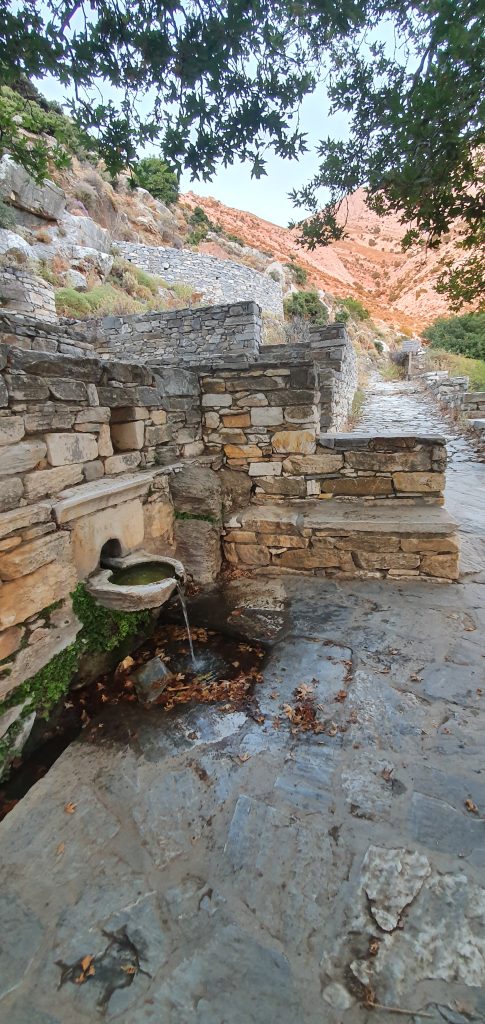
The Ai Lias Mountain Drilling: Water From the Peaks
The Ai Lias mountain drilling is another important water source on the island. Located on the eastern side of Naxos, Ai Lias mountain has been home to a drilling system that taps into the aquifers deep within the mountains. This drilling system allows locals to access high-quality, fresh water, which flows down from the peaks. The water from Ai Lias is known for its exceptional clarity and refreshing taste, making it an invaluable resource for the villages below. The drilling system here is a testament to the ingenuity of the islanders in harnessing the power of their mountainous landscape to provide for their needs. The villages of Filoti, Damarionas, and Agiasos draw their water from this borehole.
The Ai Lias Mountain borehole has long been a source of controversy among locals, sparking heated debates and even protests. Facing water shortages, the Municipality sought to claim this vital resource, leading to fierce resistance from the community. Tensions escalated, protests intensified, and law enforcement was eventually involved. In the end, Naxos town was granted a small share of the water, but the borehole remains essential to the villages of Damarionas, Agiasos, and Filoti—thriving communities with significant populations that play a major role in the island’s local vitality. With abundant herds of goats, sheep, and cows, these villages rely on this precious water source to sustain their livestock, agriculture, and way of life.
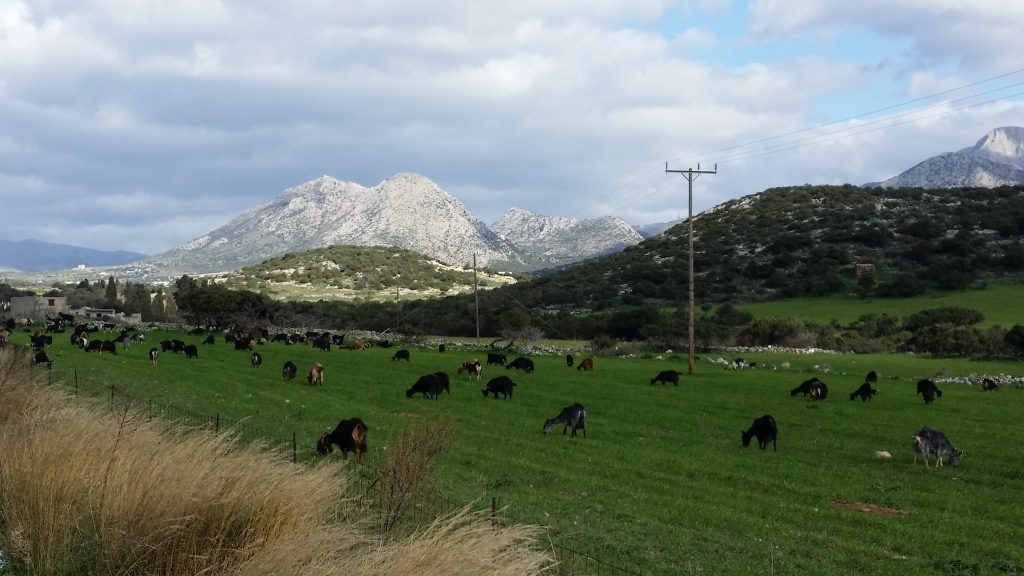
The Garinou Spring: Abundant Water in Kinidharos
Located in Kinidharos, a charming village nestled in the island’s interior, the Garinou Spring is another very vital water source for Naxos. Situated in a valley just behind the village, it takes about 40 minutes to walk from Kinidharos to reach the spring. Known for its abundant supply of fresh, clean water, the Garinou Spring has sustained the people of Kinidharos for generations. Its generous flow makes it a reliable source for both domestic use and agriculture. Kinidharos, renowned for its traditional stone architecture and rich agricultural heritage, owes much of its prosperity to this spring, which supports the local farming community and ensures a steady water supply throughout the year. The route to the spring offers a beautiful hiking trail, allowing visitors to immerse themselves in the pure, unspoiled beauty of the island’s highlands. The spot is accessible either on foot or by a 4×4 vehicle, providing a unique way to explore the island’s natural landscape. Naxos town gets water from this spring also.

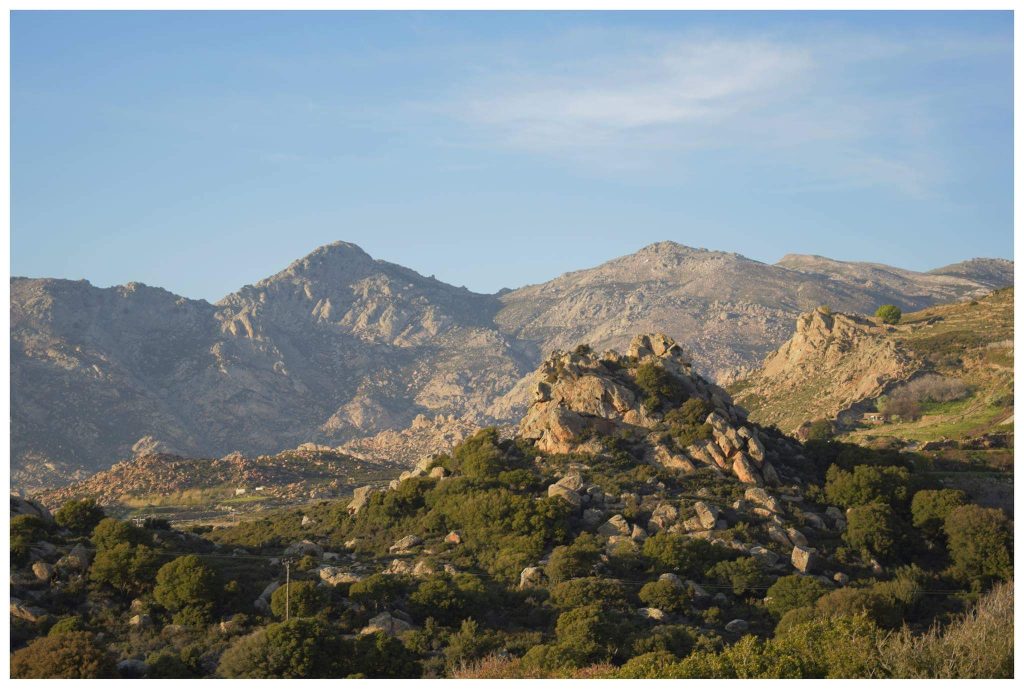
Danakos Village: A Serene Retreat with Natural Springs and Summer Concerts
Nestled in the heart of Naxos, Danakos village is a hidden gem, where natural spring waters flow through a picturesque canyon all the way to the ocean. These waters have been an essential resource for the village and the local farmers, nourishing their year-round crops and sustaining the village’s agricultural heritage. Visitors to Danakos can immerse themselves in the serene surroundings, enjoying the tranquility of the village. Under the shade of an ancient plane tree, they can relax and taste the fresh, cool spring water directly from the source, experiencing the pure essence of the land. The spring’s beauty, combined with the peaceful atmosphere of the village, offers a true taste of Naxos’ natural wonders. The water is safe to drink.
In this idyllic spot, every summer, Danakos village becomes a vibrant hub for Greek music, hosting numerous concerts that attract thousands of visitors. Set against the serene backdrop of the canyon and the tranquil flow of the spring waters, these events offer a unique cultural experience. Visitors gather under the stars, surrounded by nature’s beauty, to enjoy the soulful sounds of Greek music, creating an unforgettable fusion of tradition, music, and nature. The harmony of melodies paired with the peaceful surroundings makes for an extraordinary celebration of Greek culture in one of Naxos’ most enchanting settings.
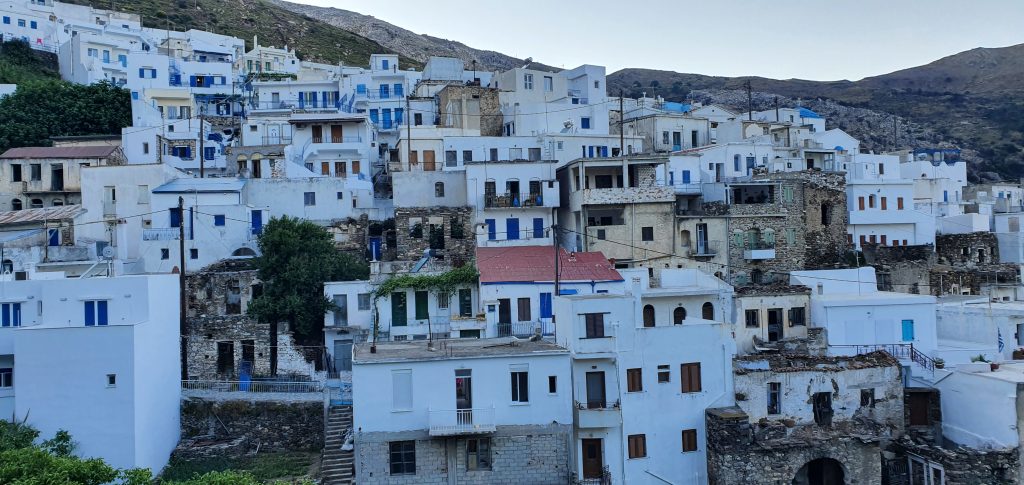
Naxos’ Rich Tradition of Wells, Fountains, and Water Sources
Naxos boasts a rich tradition of water sources, evident in the numerous wells, windlass wells, and fountains scattered across its villages and countryside. These water features can be found in various places, from the yards and gardens of homes to the lush orchards that dot the landscape. They are also a common sight in places of social significance, such as the central village squares or next to important buildings like churches. As you explore Naxos, you’ll encounter a stunning array of these charming, traditional water sources, each with its unique character, quietly connecting the island’s people to their heritage and its bountiful natural resources.
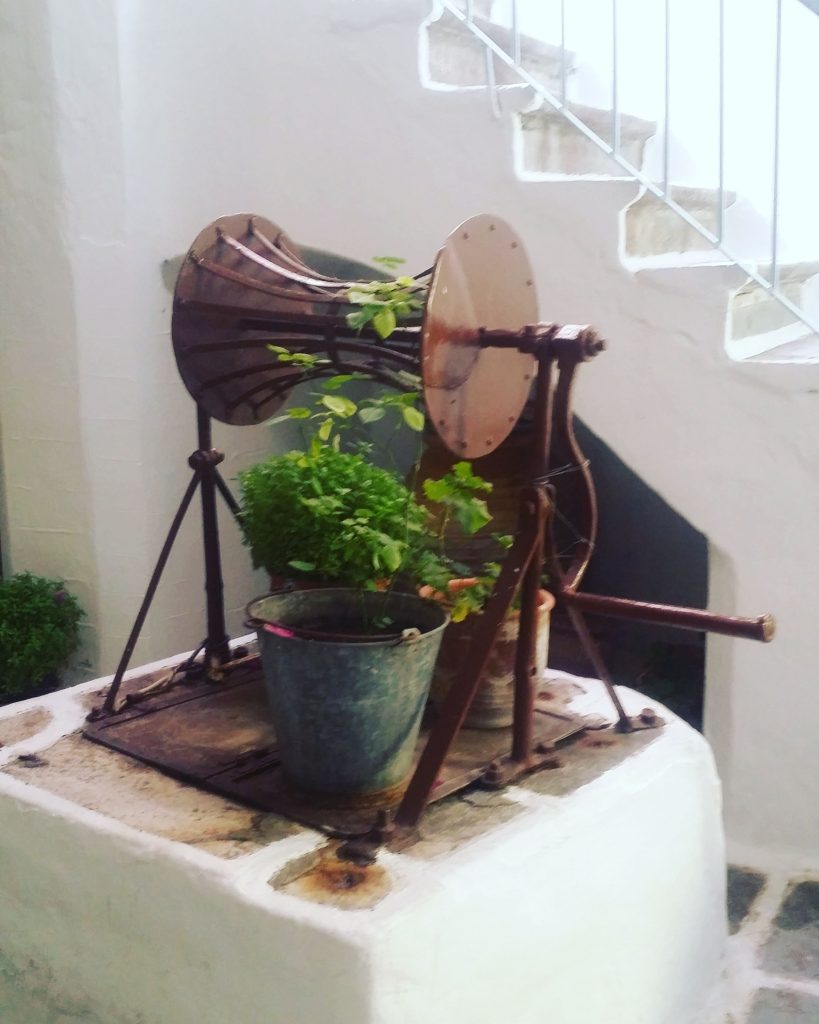
Koronos, Skado and Komiaki Villages
In the villages of Koronos, Skado, and Komiaki, boreholes and natural springs provide essential water for daily life. Nestled in the northern part of Naxos, these villages have long relied on underground natural water reserves, accessed through boreholes. This water source is crucial for agriculture, sustaining local farmers and their land. Clear and fresh, it not only nourishes but also strengthens the deep-rooted traditions of the island. The people of these villages continue to live in harmony with their surroundings, using these natural sources to support both their agriculture and daily routines.If you find yourself in any of these villages, you can safely drink the water.
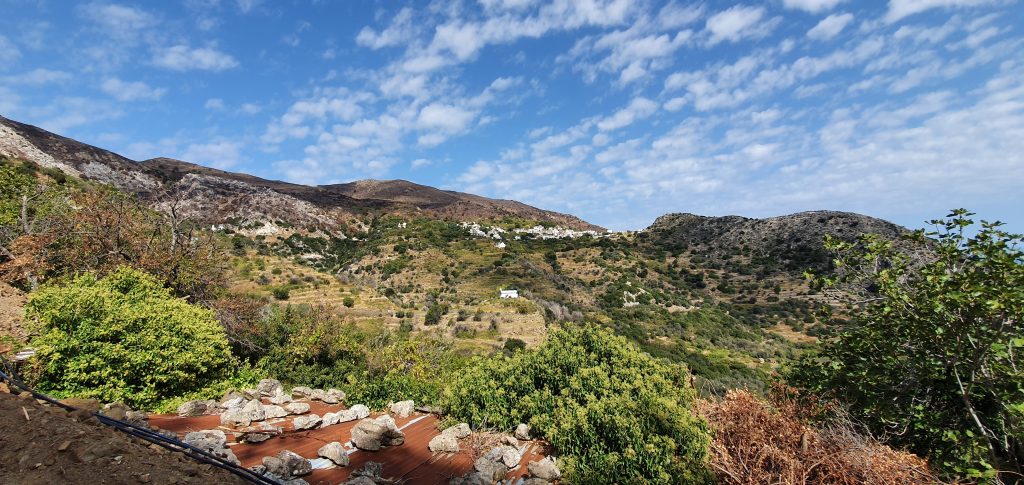
Exploring Naxos: Water Sources in the Villages
- Kastraki and Mikri Vigla: Water is sourced from a borehole in the nearby Oskelos. However, it is not drinkable. It’s recommended to use bottled water when staying in these areas.
- Galanado, Agersani, Tripodes: The water in the houses is not drinkable. These villages get their water from the Skoulikaria spring in Kinidharos. Locals can access public fountains to get drinking water.
- Apeiranthos and Moutsouna: These villages have high-quality drinkable water, sourced from boreholes in the Korakia area.
- Melanes: Water is sourced from the natural spring of Kouros, providing safe and drinkable water.
- Eggares: The village gets its water from the Skoulikaria natural spring of Kinidharos, and it is safe to drink.
- Khalkion (Chalki), Kerami, Heimaros, and Tsikalario all source their water from the Kerami borehole, which provides drinkable, high-quality water. Additionally, at the entrance of Tsikalario village, on the way to the Upper Castle, you’ll find an ancient natural spring. This spring offers crystal-clear, fresh water, and many locals visit it to experience its refreshing taste and purity.
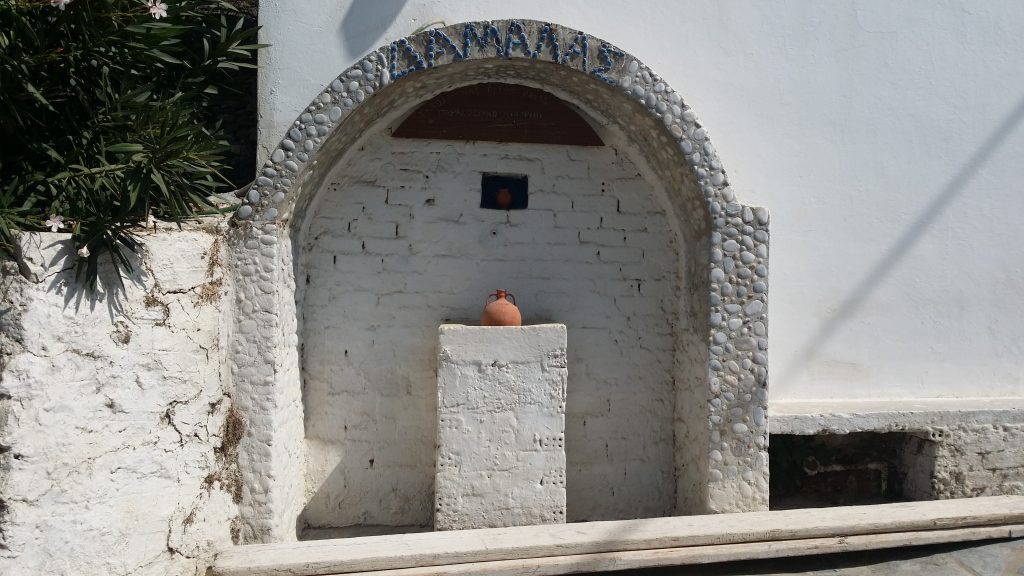
A Natural Legacy of Naxos
The springs of Naxos represent more than just a source of water—they are a testament to the island’s connection with nature and its commitment to preserving its resources. From the highland springs in the shadow of Mount Zas to the abundant sources in Kinidharos, these natural aquifers have been integral to the island’s way of life. In an age of increasing environmental awareness, these water springs stand as a reminder of the island’s timeless beauty and the importance of sustainability in maintaining the harmony between nature and human life.
When visiting Naxos, make sure to experience the island’s springs firsthand. Whether hiking to the Aria Spring at the base of Mount Zas, sipping fresh water from the Garinou Spring in Kinidharos, or simply strolling and learning about the Fanari Spring in Moni, these natural resources offer a refreshing way to connect with the true spirit of the island.
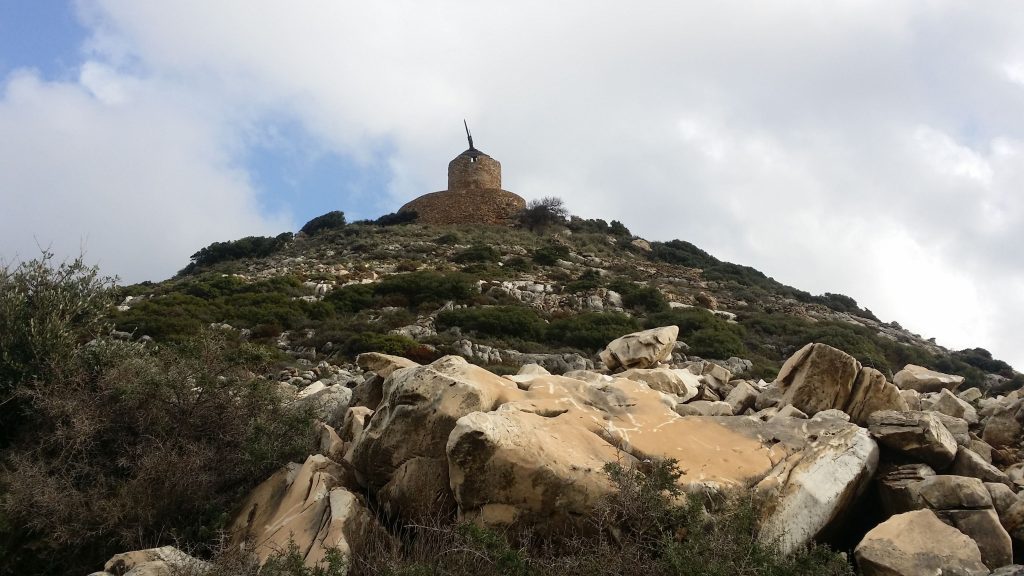
Current News as of April 2024 – Water Crisis and Drought in Naxos: A Balancing Act Between Tourism Growth and Local Needs
In recent years, the rapid influx of tourists to Naxos has sparked a building boom across the island, with new hotels, villas, and Airbnb properties sprouting up—most of which feature private pools to cater to the high demand for luxury accommodations. While tourism brings economic benefits, it has also placed tremendous strain on the island’s already limited water resources. A growing drought, marked by insufficient rainfall during the winter months and extended dry periods, has worsened these challenges, leading to significant water shortages.
To meet the demands of tourism, the municipality has taken drastic measures, including drilling for new water sources and renting desalination equipment for Naxos Town to supply the increasing number of visitors. In response to this growing crisis, the municipality raised local taxes by 700% as of January 1st, 2024, to fund water desalination, drilling, and infrastructure improvements, indirectly discouraging water consumption due to the excessive financial burden on residents.
For local farmers, the situation is dire. The island, which is famous for its PDO (Protected Designation of Origin) potatoes and agricultural heritage, is facing hardships. Shepherds, potato farmers, and other agricultural workers are struggling to maintain their livelihoods, as water scarcity threatens the productivity of Naxos’ fertile lands. In an effort to cope, many locals have adopted water-saving measures and more sustainable farming practices, working together to minimize water consumption in the face of growing challenges. The delicate balance between tourism growth and preserving the island’s agricultural heritage remains an ongoing issue for Naxos.
The locals of Naxos’ mountainous villages have found themselves in fierce confrontation with the Municipality over the heavy taxes imposed on them. These taxes, designed to address the desalination and water scarcity issues in Naxos town and its surrounding tourist areas, have become a point of contention. The villagers argue that, while they are being burdened with these taxes, they themselves do not face water scarcity issues. Despite their protests, the Municipality has yet to revise its stance, and the financial impact continues to affect the entire island and its residents.
At ELaiolithos, we stand firmly in support of Naxos’ mountainous region, its hard working farmers, and local businesses. Our commitment to these communities is rooted in our belief that they should not bear the brunt of taxes meant to address challenges they do not experience. By championing this region, we aim to preserve its authenticity and strengthen its future.
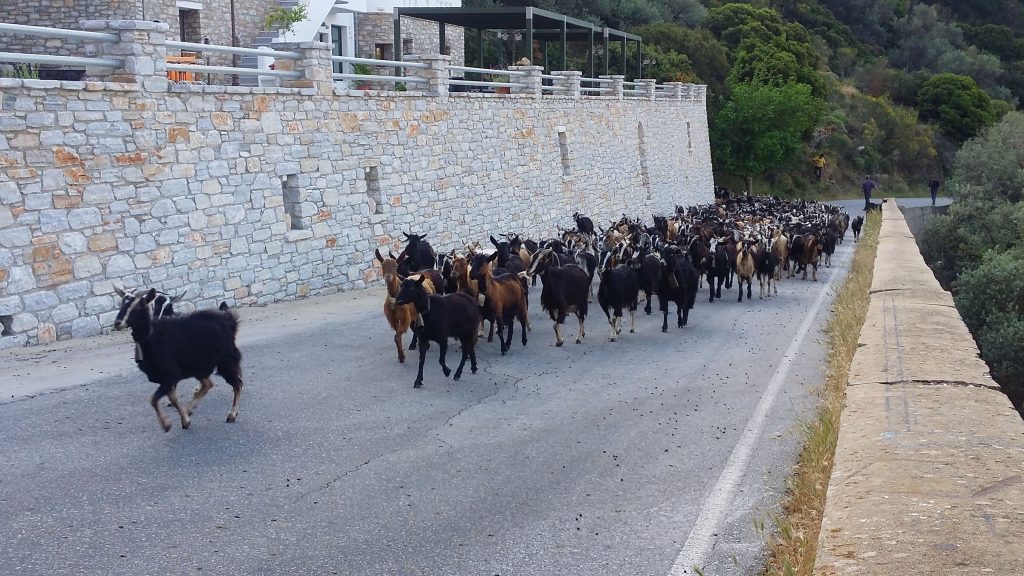
Naxos: The Power of Water in Sustaining Life and Prosperity
Water is more than just a resource for the people of Naxos—it is the lifeblood of their communities, sustaining traditions, agriculture, and daily life. Blessed with abundant water sources, Naxos stands as the most fertile island in the Cyclades, allowing it to be largely self-sufficient. Its rich lands not only nourish the local population but also produce goods that are exported to surrounding islands, the rest of Greece, and even beyond. From mountain springs to village wells, water connects generations, nurtures the land, and reinforces the deep bond between the locals and their environment.
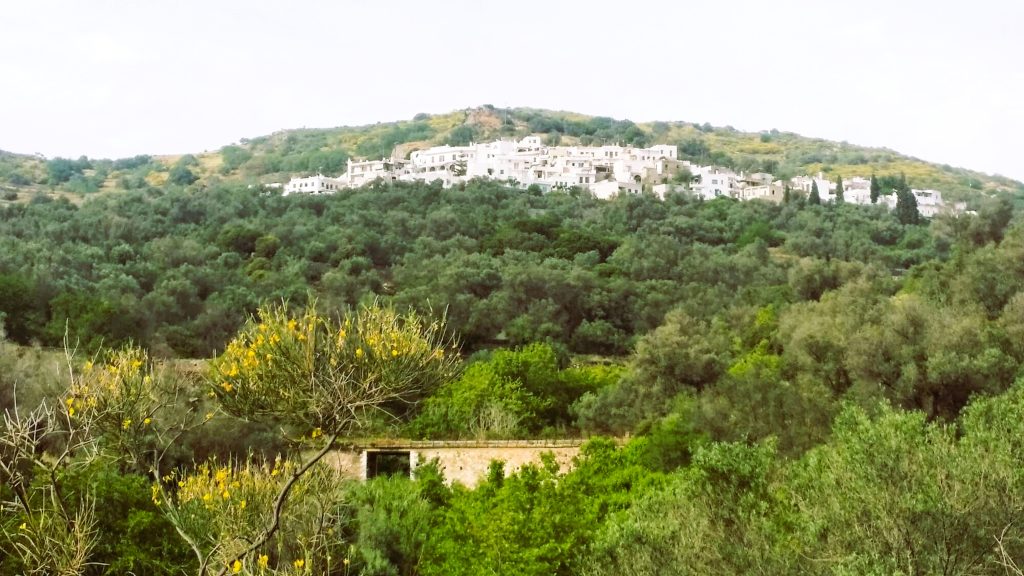
P.S. Your thoughtful water usage not only helps preserve the beauty and resources of Naxos but also directly contributes to the sustainability of the island for future generations. By using water responsibly, you play a part in supporting the local communities, helping to reduce costs for the villagers and ensuring their continued well-being. Thank you for supporting this vital effort!




